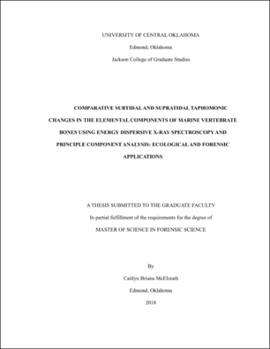| dc.contributor.advisor | Lord, Wayne | |
| dc.contributor.author | McElreath, Caitlyn Briana | |
| dc.date.accessioned | 2020-07-09T14:40:13Z | |
| dc.date.available | 2020-07-09T14:40:13Z | |
| dc.date.issued | 2018 | |
| dc.identifier.other | (AlmaMMSId)9982593883002196 | |
| dc.identifier.uri | https://hdl.handle.net/11244/325067 | |
| dc.description.abstract | Individuals and agencies of multiple disciplines have evolved interests which result in the studies and research of marine mammals as well as other protected marine dwellers such as sea turtles. Aside from wildlife conservation, an exponential increase in interest to these protected animals has been the side effect of trade for profit to fund activities targeted at human populations as acts of terror. Experts believe that wildlife trade and trafficking is being used to finance terrorist and criminal activities (Wyler & Sheikh, 2013). This study focuses on observations made by analysts while examining remains of protected animals that may be involved in trade or trafficking on the black market such as marine vertebrates. According to U.S. Fish and Wildlife Forensic officials, recent observations have found that marine organisms like the sea turtle and harbor porpoise display signs of advanced taphonomy and even premature fossilization following decomposition. Because of this observed advanced decay, analysts find it difficult to effectively and efficiently age marine bone specimens. In an attempt to develop a less costly and time-consuming method for analyzing marine bone specimens, this study was created in which bone samples were observed over the course of a year. In this study, skeletal remains from submerged marine vertebrates including a porpoise, seal, sea turtle, and a bovine cow control were sampled to determine a plausible explanation for these observations. The specimens were necropsied prior to submersion, and the bones of each vertebrate were segregated with respect to species. Periodic samplings took place over the course of one year. Using the Scanning Electron Microscope (SEM), the bone specimens were examined for topographic changes and analyzed for elemental composition. Among the different elemental aspects of bone composition, a list of elements was compiled and monitored for change throughout the duration of 12 months. | |
| dc.rights | All rights reserved by the author, who has granted UCO Chambers Library the non-exclusive right to share this material in its online repositories. Contact UCO Chambers Library's Digital Initiatives Working Group at diwg@uco.edu for the permission policy on the use, reproduction or distribution of this material. | |
| dc.subject.lcsh | Forensic taphonomy | |
| dc.subject.lcsh | Aquatic animals | |
| dc.subject.lcsh | Wildlife crime investigation | |
| dc.subject.lcsh | Marine ecology | |
| dc.title | Comparative subtidal and supratidal taphonomic changes in the elemental components of marine vertebrate bones using energy dispersive x-ray spectroscopy and principle component analysis : ecological and forensic application. | |
| dc.type | Academic theses | |
| dc.contributor.committeeMember | Jourdan, Thomas | |
| dc.contributor.committeeMember | King, Kama | |
| dc.thesis.degree | M.S., Forensic Science | |
| dc.subject.keywords | Anthropology | |
| dc.subject.keywords | Forensic science | |
| dc.subject.keywords | Taphonomy | |
| dc.subject.keywords | Wildlife forensics | |
| dc.identifier.oclc | (OCoLC)on1041143956 | |
| uco.group | UCO - Graduate Works and Theses::UCO - Theses | |
| thesis.degree.grantor | Jackson College of Graduate Studies. | |
